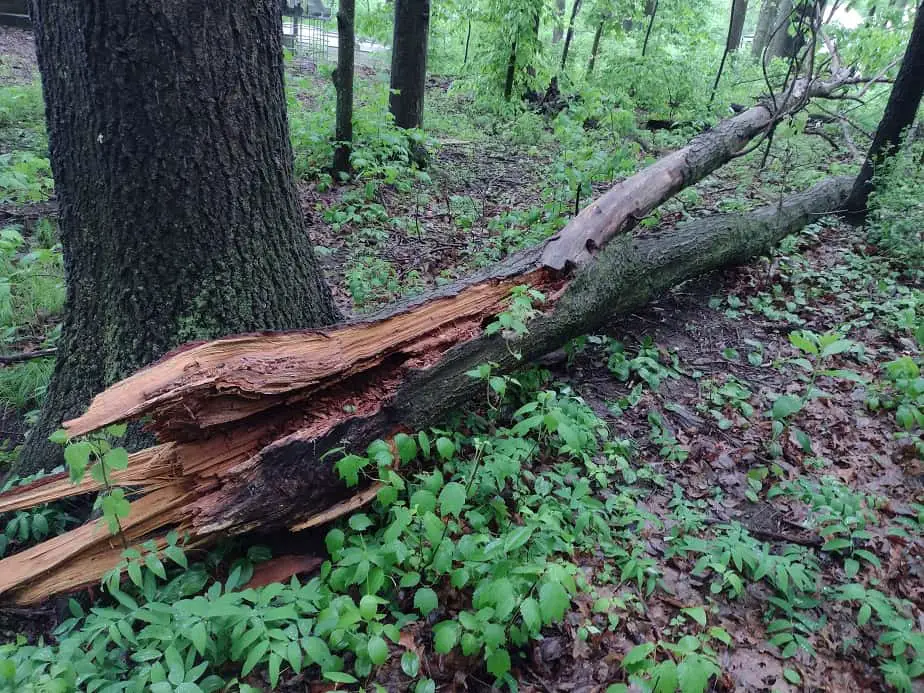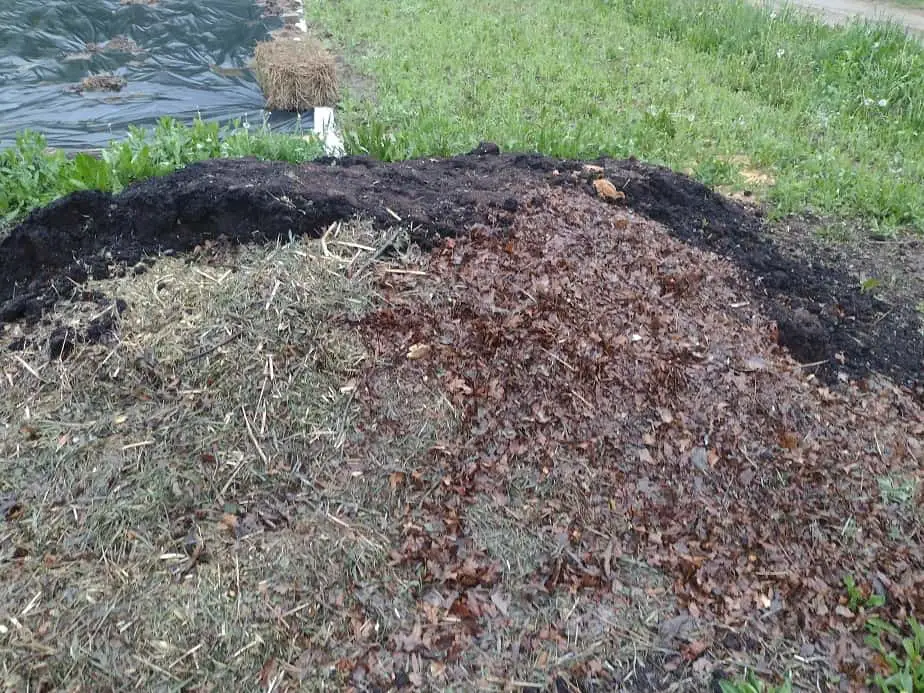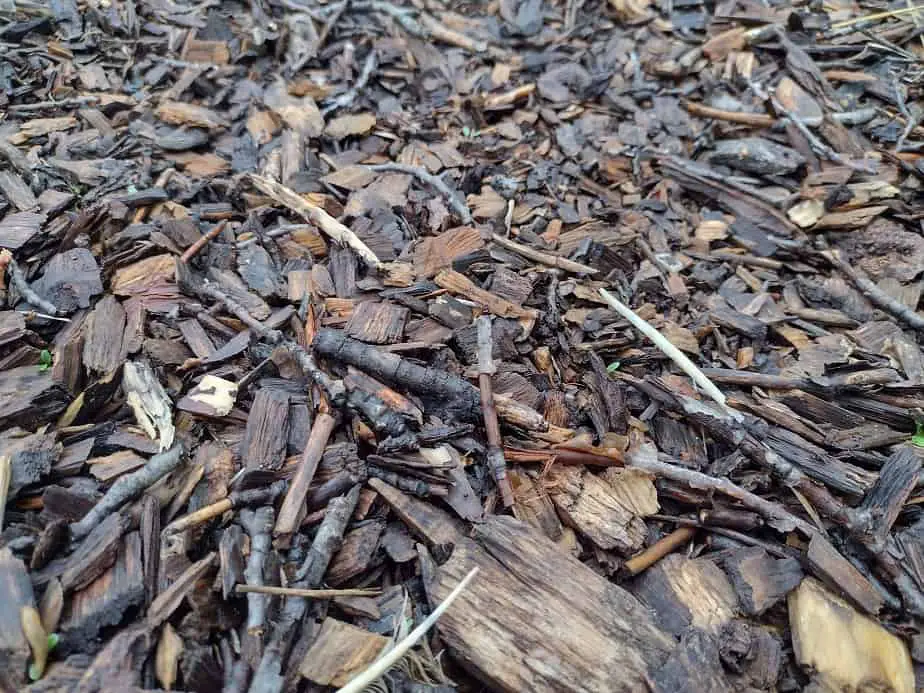Woodchips
One of the most beneficial and easiest to source fillers for a raised bed is untreated woodchips. Whether you need drainage, a boost to organic matter, or want a bottom barrier, Woodchips will do. Woodchips are amazing in the garden. 6-inches of woodchips at the bottom of a bed will really make it nice.
I know some people say you can’t use woodchips because “they’ll use up all your nitrogen”. Well, not quite. Plants need a lot of nitrogen. Woodchips don’t have any nitrogen. like straw, leaves, or anything else really, composted woodchips aren’t a complete diet for plants.
When I was a kid watching Saturday cartoons, they used to have advertisements for that unnaturally colored, overly sweetened cereal. The ads would end in “part of a complete breakfast”. Woodchips are part of a complete meal for your plants, not the whole thing. Now, it does have one secret.
There is a material called humic acid. Humic acid is what makes compost dark-colored. It’s a humungous chain molecule containing a ton of carbon, and everything else too. Remember in high school chemistry about the carbon bond? Carbon forms a high-strength bond to all other life-supporting elements.
Bear with me here, it’s important. So, this giant chain molecule of carbon and everything else, that is held strongly together (humic acid) feeds beneficial soil fungi (and some good bacteria too). The result is a long-lasting carbon-rich, fertile soil that breaks down over time to feed the soil life.
Since soil life is everything, let’s do that eh? How do we get humic acid? Woody materials create a high humic acid compost. As long as you are giving your soil the rest of a complete diet, woodchips are a super amazing addition to garden soil.

Brush
Brush and brush cuttings can be an amazing bottom layer to a raised bed garden. It breaks down into a high humic acid organic matter, feeds soil fungi, and also allows great drainage. It doesn’t really matter what kind of brush trimmings are used, they all help the soil.
Some types, like juniper, cedar, and locust don’t really rot down into organic matter. But, those ones would still benefit drainage. You can take any sort of tree or brush trimmings and layer them as a base on the bottom of your raised bed. Bugs love it and plant roots can easily wander around them.
I have even layered brush trimmings down on the ground over my no-till garden beds. It really helps minimize erosion, increases beneficial fungi, and garden-friendly bugs a great place to crawl under. They will probably send you a thank you letter.

Logs
Logs as a soil layer are getting more popular with the rising interest in Hugelkultur gardening. That is, burying a pile of logs with 1-3 feet of soil and planting over it. The idea is that you get a long-lasting organic layer, full of beneficial fungi and plant-feeding materials.
Fill up to the lower half of your raised bed with logs, then burry them. it will allow good drainage, and make the soil microbes very happy. The Hugelkultur method is really just building a long-term mansion for soil life, focusing on woody material for that humic acid. It really does work.
Sand
This one can be controversial, but it’s natural and useful in many instances. If I dig down anywhere in my garden, I’ll hit a layer of clean sand after a foot or so. My soil base is sand, and it’s a very healthy, productive, well-drained soil. Sand is usually cheaper to purchase than garden soil.
If you have drainage concerns, a layer of sand will help out a lot. Sand is full of plant benefitting minerals. it’s only a problem if there’s too much, or too little anything else. Just like before, “part of this complete breakfast”. Sand is an important part of good soil. Most gardeners prefer soil with a sandy base layer.
I would be more than okay with a tall raised bed with the top 10 inches having decent topsoil, and the rest filled with sand. That’s what my garden is anyway and it grows happy plants. Over time, your topsoil will mix with the top layer of sand, creating an in-between layer.
That’s the work of earthworms mainly, and it’s healthy, natural, and part of a stable garden environment. Just remember that if you use an inorganic base layer you add a bit of extra organic material to the top for worms to drag down and mix in.
Gravel
Gravel is a fairly common base for raised beds. It offers increased drainage and it’s cheap, but you have to be careful with it. Gravel is harder for plant roots to grow around. It takes about three times as much energy for plants to push roots through gravel than fine soil. You don’t want to use too much.
Generally, three or four inches of gravel is enough to help a drainage issue. I would recommend if you want to use gravel as a filler to mix it with soil, so it’s not just an impenetrable, shield-like layer. Plant roots tend to look for the path of least resistance. They don’t like thick gravel layers.
Gravel or pea rock can help soil that’s too mono-formed; Soil that doesn’t have a good variety of base minerals. Gravel tends to be a wide variety of stone types, which will add a good mix of inorganic elements and minerals into the soil. Microbes in the soil break down the face of stones and release minerals in a plant-friendly form.

Hay or Straw
Hay and straw are maybe the most popular things to bury in a raised bed. They both break down fairly quickly, feed soil microbes, and improve drainage. They’re both amazing, but, they have different effects on the soil.
Straw is a quality organic material. It usually has some leftover grain seeds in it, but that’s not a problem if you’re burying it at least 6 inches deep. Straw is a little like wood. It’s full of carbon but doesn’t have a lot besides that. There’s no issue with it, but it’s not a “fertilizer” like hay can be. I use a lot of straw.
Hay has a wider assortment of minerals, especially nitrogen. It breaks down a bit faster than straw in my experience. Hay is full of organic matter, but also feeds the microbes a lot more than straw. The higher mineral content of hay builds much more fertile soil than straw and requires fewer soil amendments.

Grass Clippings
Everyone should use grass clippings in their garden. It’s basically free hay. I can’t stand to see piles of grass clippings thrown on the side of the road because someone thought it was trash. I bought a bagging mower just so I could put the clippings in my garden.
Grass clippings are a nitrogen-rich organic material. They break down quickly, feed the soil, and really work to build up the soil’s carbon content. If you want a deep layer of clippings, I’d suggest piling them up and letting them break down just a bit first. You can also simply mix them a bit into the dirt.
I would be willing to use up to 50 percent grass clippings in a raised bed. A 2-6 inch layer on the bottom, and then a thin layer every few inches throughout the soil. Boy, that’d create some super-soil.

Leaves
Leaves are God’s gift to gardeners. They are full of minerals from deeper in the ground and fall down like an offering to you. Leaves are an awesome soil amendment, and mulch too. Leaves break down into what’s known as leaf mold, also called gardener’s gold.
Leaves feed soil fungi, and all sorts of beneficial bacteria and soil bugs. Worms especially love leaves. They love crawling through wet leaves and munching away on them. Leaves are best mulched before mixing in the dirt. A mower with a bag, set to the lowest setting does a great job at that.
You can add leaves to your soil in the fall, and they will be mostly broken down by spring. They go fast. Next time your neighbor forgets to rake his yard, perhaps offer to save him the trouble and collect them for your garden. You can use a ton of leaves, they break down fast in healthy, living soil.

Manure
I have a raised bed filled mostly with manure and composted manure. It’s pretty fertile. Manure is often cheap and is an amazing soil amendment. Un-composted manure can make up to half of the soil in a raised bed without concern. I like to use it to fill the lower half of the bed.
Manure of every type is used in agriculture. Most of it all has the same nutrient base. That is: a ton of carbon, a bit of phosphorus and potassium, and a little nitrogen. Most manures, by the time you get them, are fairly devoid of Nitrogen. And no, manures will not burn plants.
Super fresh manures generally contain up to 3 percent nitrogen. That nitrogen tends to leach out as nitrogen gas and very quickly goes away. If you get a pile of somewhat dry manure from a farmer or someone with horses, it’s probably pretty low in nitrogen at that point.
I have literally used several tons of manure in my 1/2 acre garden. The secret to my potted plants is manure laced with fairly fresh chicken manure and composted horse manure. Who needs Miracle-Gro, right? Check out Facebook Marketplace to see if someone is offering manure in your area.
Most of the time, it’s free for the taking. If you’re not too far, you may be able to pay them for delivery. Wouldn’t that be nice? Chicken and rabbit manure is my favorite because they never contain weed seeds. But, seeds aren’t a concern if it’s at least 6 inches buried. Dog and cat work too.
If you have a foot or so of healthy soil overtop of manure, it will break down pretty quickly and will just end up smelling like nice, earthy dirt. That reminds me, I need to call my neighbor down the road and request another load of manure.
Christmas Trees
Every year, our Christmas tree ends up in the garden either as a mulch in a no-till bed or as organic matter Hugelkuktur style. This is one reason why I prefer a Christmas tree that wasn’t sprayed with that green, fire-retardant paint stuff.
Lop off the branches close to the trunk then cut the trunk into 2 or 3 pieces and bury them together in your raised bed. I use a machete, but a hatchet or saw works too. Don’t worry about evergreen trees being acidic. It’s not a real concern, nature will take care of it.
I do like to use wood in the garden. I’ve even used old firewood and scrap 2x4s as a filler for the base of a garden bed. Wood is good. Low in nitrogen, but part of a super garden diet. As always, I recommend a soil test at the beginning and end of each growing season. The Lusterleaf 1602 is my favorite soil test kit.
Related Articles:

